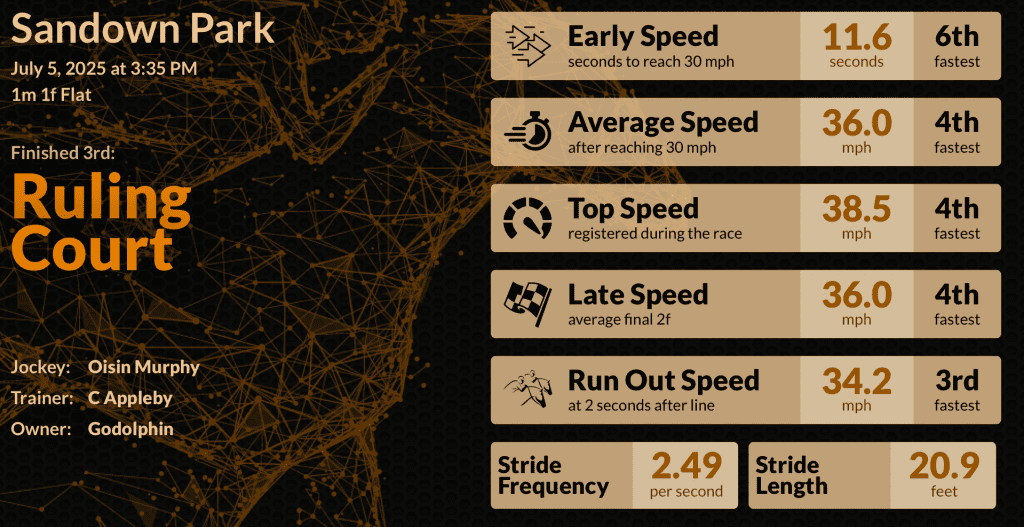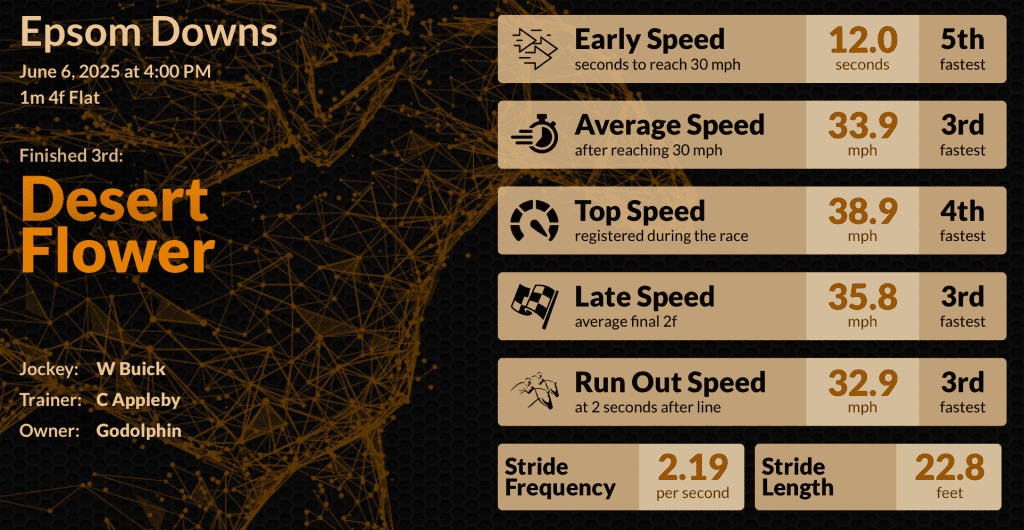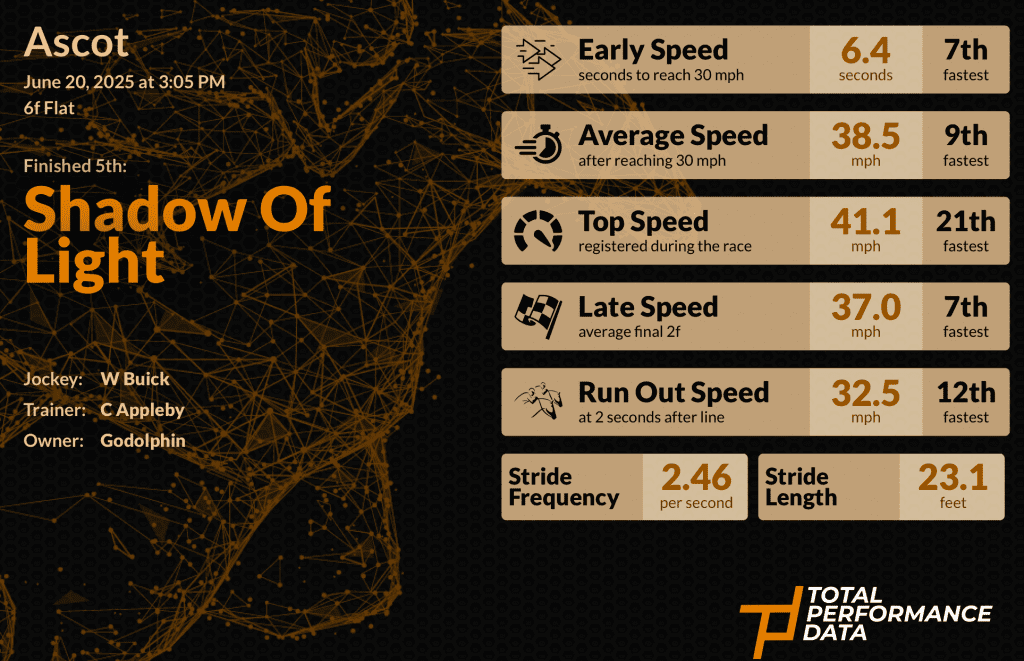Weekly Review 14th July - Charlie Appleby
I’ll take a slightly different approach with this week’s blog. When Charlie Appleby and the Godolphin team left Newmarket at the end of the Guineas meeting, they must have been delighted. Ruling Court had won the 2,000 Guineas and Shadow of Light had run a very promising race to finish 3rd, whilst Desert Flower had proved to be far too good for the rest in the Fillies race. Since then, the 3 Classic performers have yet to trouble the judge and a couple of 3rd place finishes in the St James’ Palace Stakes and the Oaks is the best that they have mustered. That could be seen as a disappointment and there is no doubt that their connections will clearly have had higher hopes than that, but are they right to be disappointed? Here’s a look at all 3 horses since their Guineas runs and what the data can tell us about their subsequent form.


Ruling Court
Already a dual Guineas winner this season, it could be argued that his best performance actually came in Dubai in March. A top speed of 41.25 mph in the Jumeirah 2,000 Guineas at Meydan in March saw him come from last to first to win by 6-lengths, closing with the best final quarter of a mile split in 22.56s. At 25.95 ft, he had the highest peak average stride length in the field that day and ran out a comfortable winner under William Buick. He beat horses rated 91 and 93, so there is some context needed to the overall strength of the form and whilst he was a winner at Newmarket on his next start, time has shown that he was perhaps a slightly fortunate winner and if we were to run that race again, the likelihood would seem to be that Field of Gold would reverse the form. Having been a last minute withdrawal from the Derby, I’m more than prepared to forgive the run in the St James’ Palace Stakes which appeared to be an afterthought and he ran accordingly, losing time to Field of Gold over each of the final 5 furlongs. He didn’t travel, he barely picked up the bit and was beaten at the halfway point, so a line through that piece of form seems to be the best approach.
That then brings us nicely to his run in the Coral Eclipse. A 3rd placed finish behind Delacroix was a significant step in the right direction and the 10-furlong trip seemed to put him back on course. Despite sweating up and looking keen at the start, he recovered well to finish 3rd, closing in 12.72s, a time only surpassed by the winner. The start was the key. Oisin Murphy seemed very keen to settle him, but Ruling Court was keen to race, running the slowest opening furlong (14.84s) followed by the fastest 2nd furlong (11.79s). The Eclipse had a stop/start pace as Maxime Guyon attempted to control the pace in front onboard Sosie, but with a finishing speed of 103%, the pace was turned on from the 3-furlong pole and Ruling Court’s individual splits rank 4th, 4th and 2nd for that part of the race. Camille Pissarro lost his left fore shoe in the straight, which caused him to wander around in front of Ruling Court, forcing Oisin Murphy to make adjustments at a crucial stage. Having been 0.56s slower than Delacroix over the last quarter of a mile, he seems unlikely to reverse this form, though with a clear run he may have got closer, but the fact that he recorded a top speed figure of 38.50 mph and the way he finished the race would suggest that he is capable of winning a race over 10-furlongs. He’s held by Field of Gold and the form book and the data from TPD suggest that there is no reason to think he can close the gap between them. However, his run in the Eclipse wasn’t far behind the form that he showed in the Spring and with his season back on track, he now appears to be running over the right trip.


Desert Flower
Desert Flower was the best horse in the 1,000 Guineas. She ran the fastest opening furlong in 14.93s and once in front, she was able to control the pace in front and ultimately none of the other Fillies were able to get alongside as she made every yard in the far side group. That form has certainly taken some knocks. Lake Victoria is the only Filly in the field to have won a race since and if we assume that she didn’t run her race at Newmarket, which her Irish 1,000 Guineas romp would suggest is the right approach to that form, then it puts a very different spin on the form. Desert Flower ranked 8th for Top Speed (39.30 mph), 4th for Run-Out Speed (33.29 mph) and 6th for her Peak Average Stride Length (23.92 ft). Hindsight is a wonderful thing but that data might have suggested she wasn’t likely to stay the trip at Epsom, regardless of how she handled the track and so it proved. She ran a fair race to finish 3rd behind Minnie Hauk and Whirl in the Oaks and given that she was unbeaten at the time, her connections were almost obliged to try and win another classic. However, at no point in the race was she able to run the fastest individual furlong split. Whilst the softer ground may have been a contributing factor and there is always a doubt as to whether a horse will handle the track at Epsom, her opening furlong ranked only 4th in the Oaks and she wasn’t able to control the pace in the manner she had at Newmarket. A finishing speed of 109% would suggest that the Oaks wasn’t run at and end-to-end gallop and the winning time of 2:38.91 was only par for the course (there have been 7 faster winning times in the last 12-years) and so it would too simplistic to assume that she didn’t stay. She’s clearly a very talented filly, but the Aidan O’Brien trained pair that finished in front of her are much stronger stayers over 12-furlongs and the data would suggest that a return to a more conventional track and a shorter trip would be the better move with Desert Flower. Given the early speed that she showed at Newmarket, racing around a bend should help her cause.


Shadow of Light
Shadow of Light was the fastest horse in the 2,000 Guineas at Newmarket where he recorded a top speed of 40.82 mph, faster than both Ruling Court (40.04 mph) and Field of Gold (39.95 mph). Making ground on the far side of the group, he ran the fastest 6th and 7th furlongs in the race and having hit the front at the bottom of the dip, he was perhaps disappointed to only finish 3rd. Having been faster than the other 2 in the preceding furlongs, he perhaps didn’t stay, but he had a strong pace to quicken behind and showed plenty of speed. That would suggest that the return to 6-furlongs at Ascot should have suited, but it didn’t. His top speed figure of 41.14 mph was the slowest of the 21-runners that went to post and his average stride length of 23.25 ft was below the TPD expected figure. I should add that the ground may have been to blame and his best form as a 2-year-old certainly came with some juice in the surface. He ran respectably at Deauville, where he was the fastest horse in the 5th furlong before not quite getting home. Being drawn wide in stall 9 probably didn’t help and had he made his challenge closer to the stands rail, he may have had a winning chance. However, over the final 600m he took 34.23s, a time only beaten by Woodshauna. Whilst Maranoa Charlie may well have won if he had run in a straight line, the form looks relatively strong and this was a step in the right direction. A penetrometer reading of 3,6 would be close to “Good to Soft” in UK terms and that appears to have aided his cause. He showed mid-race speed in a race run with a finishing speed of 106%, but his final furlong ranked 4th (11.81s), even though his race top speed figure of 65.5 km/h was the fastest of the principles. There were plenty of positives to take from his 4th placed finish in the Prix Jean Prat, which was at least 10 lbs better than his Ascot run, but whilst he shows good speed in the middle part of his races, he isn’t finishing his races well and whilst I’d still argue that 6-furlongs is his best trip, I suspect that he may also need to be played later to use that turn-of-foot in a short, sharp burst.